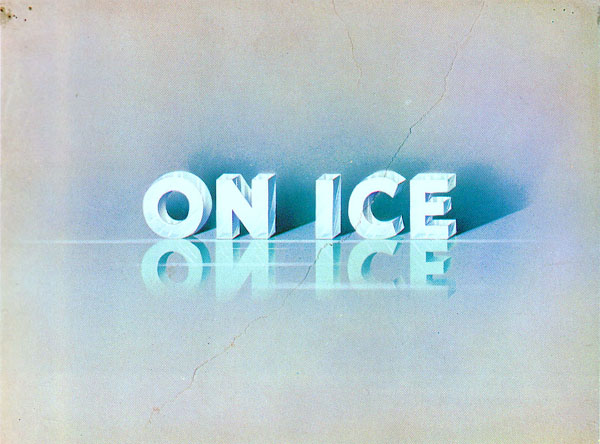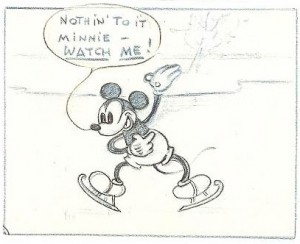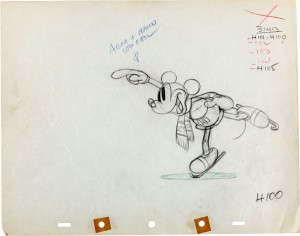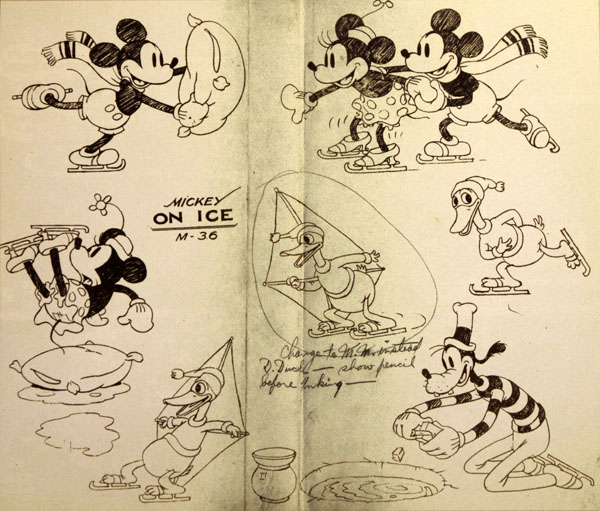
This week, we’ll look into another bona-fide Disney classic!
On Ice, released late September 1935, blends two breeds of artists present at the studio — seasoned animators that enriched their characters’ personalities, and their less experienced counterparts, including young animators that would eventually help the studio become the powerhouse of the animated medium.
There is some strong casting by character in this cartoon with Art Babbitt on Goofy, Fred Spencer on Donald, and Norm Ferguson on Pluto. There is also effective casting by sequence, with Don Towsley handling the climactic rescue at the end. The careful casting didn’t extend to Mickey, who is variously animated by Paul Allen, Marvin Woodward, Eric Larson, and Johnny Cannon. Budding animator Milt Kahl, hired at the studio in the summer of 1934, handles the opening scene’s cyclical animation of mass skating.
 Ben Sharpsteen was the first New York animator recruited to the studio in March 1929, having previously worked for the International Film Service, the Jefferson Film Studio and Fleischers. He was also the first animator hired after several artists left for the Winkler studio, headed by Charles Mintz. Disney’s proved to be a different experience, with the minute detail of their exposure sheets and their synchronization to sound. Sharpsteen first assisted director Burt Gillett on the early Mickey Mouse cartoons but assumed the directorial role when Gillett left for Van Beuren by the
Ben Sharpsteen was the first New York animator recruited to the studio in March 1929, having previously worked for the International Film Service, the Jefferson Film Studio and Fleischers. He was also the first animator hired after several artists left for the Winkler studio, headed by Charles Mintz. Disney’s proved to be a different experience, with the minute detail of their exposure sheets and their synchronization to sound. Sharpsteen first assisted director Burt Gillett on the early Mickey Mouse cartoons but assumed the directorial role when Gillett left for Van Beuren by the fall spring of 1934. His Disney cartoons as a director often follow a template where an ensemble of characters – in this case, the trio of Mickey, Donald and Goofy — engage in individual pieces of “comic business” and the events cohere as the climax occurs. Examples of this sort include Mickey’s Fire Brigade, Moving Day, Moose Hunters, Clock Cleaners, and Polar Trappers (sans Mickey).
Norm Ferguson (“Fergy”) handles the comic business of Pluto struggling to balance on ice skates and attempting to catch his frozen tail, which echoes the “flypaper sequence” from Playful Pluto, released a year earlier. Like Sharpsteen, Ferguson was another veteran East Coast animator who moved to the West Coast. He sojourned to Disney’s in August 1929, where he developed the simple staging of Pluto’s natural canine reactions through pantomime. Ferguson was inspired by the New York vaudevillians he admired. He drew rough sketches that brought out a spontaneous performance, carefully planning the timing of Pluto’s expressions and mannerisms. Ferguson could produce 40 feet a week, where the average Disney quota was about 10 or 15. The Pluto sequence here runs approximately 119 feet – around 90 seconds’ worth of animation.
 Art Babbitt’s extended sequence with Goofy shows the character’s restyling that is close to his modern incarnation, with a body more suited to his personality, instead of the gangly “Dippy Dawg” of his earlier appearances. Babbitt already realized the comedic potential of the character in Sharpsteen’s Mickey’s Service Station, in which Goofy repeatedly gooses himself on top of an engine block. The acting for On Ice is stronger. Rather than acting upon impulse, Babbitt’s Goofy is more thorough about his strategy, but can be insulted if taken for a fool. In scene 18, Goofy’s simple-minded determination turns to angry conviction as he tosses away his club to reach for a much bigger instrument to catch the fish. This, and the overlong piano moving sequence from Moving Day, cemented Goofy’s transition from chinless yokel to gullible half-wit.
Art Babbitt’s extended sequence with Goofy shows the character’s restyling that is close to his modern incarnation, with a body more suited to his personality, instead of the gangly “Dippy Dawg” of his earlier appearances. Babbitt already realized the comedic potential of the character in Sharpsteen’s Mickey’s Service Station, in which Goofy repeatedly gooses himself on top of an engine block. The acting for On Ice is stronger. Rather than acting upon impulse, Babbitt’s Goofy is more thorough about his strategy, but can be insulted if taken for a fool. In scene 18, Goofy’s simple-minded determination turns to angry conviction as he tosses away his club to reach for a much bigger instrument to catch the fish. This, and the overlong piano moving sequence from Moving Day, cemented Goofy’s transition from chinless yokel to gullible half-wit.
 Donald Duck’s early design, with a goose-like neck and long bill, was still in use for this cartoon. As with Art Babbitt’s Goofy, animator Fred Spencer soon re-designed him in a rounder fashion. This new look was used by the next year’s releases. Spencer knew the sensibility of Donald, and developed the character further in his animation for this cartoon. Spencer adds some nice touches to his scenes, such as the duck pleasingly wiggling his tail before fastening the ice skates to Pluto’s feet. He shares a scene with Norm Ferguson, as Donald continues to taunt Pluto, skating around him with a kite strapped to his back. Spencer was killed in a car accident in November 1938, at the age of 34, robbing the animation world of a great artist.
Donald Duck’s early design, with a goose-like neck and long bill, was still in use for this cartoon. As with Art Babbitt’s Goofy, animator Fred Spencer soon re-designed him in a rounder fashion. This new look was used by the next year’s releases. Spencer knew the sensibility of Donald, and developed the character further in his animation for this cartoon. Spencer adds some nice touches to his scenes, such as the duck pleasingly wiggling his tail before fastening the ice skates to Pluto’s feet. He shares a scene with Norm Ferguson, as Donald continues to taunt Pluto, skating around him with a kite strapped to his back. Spencer was killed in a car accident in November 1938, at the age of 34, robbing the animation world of a great artist.
The under-rated Don Towsley deserves more recognition for his energetic, ambitious animation. Scene 43, with Mickey recovering his momentum after precariously hopping on ice caps, is beautifully executed. Scene 45 has some nice timing when Mickey slips and falls on the ice after Donald flies across him. Like the other animators that shaped their designated characters in this film, Towsley designed a series of definitive model sheets with the three star characters, which displayed more exuberant posing, in the summer of 1937. He was assigned to a group of artists known as the “Duck unit” that primarily animated on the Donald series, and his credits last up until 1948.
 While he was still animating in the early ‘30s, Sharpsteen supervised and lent sensible advice to groups of new, younger animators. Among them was Eric Larson, who arrived at the studio in the summer of 1933. He animated small chunks of footage of Mickey and Minnie in this cartoon. One particular earmark of Larson’s prompted an angry comment from Disney. He recalled a sequence – presumably sc. 37 — where Mickey and Minnie skate along with open-mouthed smiles. Disney asked Larson if they could “ever shut their damned mouths,” and word spread quickly through the studio. One staffer stated, “I hear Walt wants you to shut Mickey and Minnie’s mouths” to Larson before he entered his room. When you look at the scenes and notice that Larson does, indeed, consistently have their mouths open, Disney’s critique seems blunt but correct.
While he was still animating in the early ‘30s, Sharpsteen supervised and lent sensible advice to groups of new, younger animators. Among them was Eric Larson, who arrived at the studio in the summer of 1933. He animated small chunks of footage of Mickey and Minnie in this cartoon. One particular earmark of Larson’s prompted an angry comment from Disney. He recalled a sequence – presumably sc. 37 — where Mickey and Minnie skate along with open-mouthed smiles. Disney asked Larson if they could “ever shut their damned mouths,” and word spread quickly through the studio. One staffer stated, “I hear Walt wants you to shut Mickey and Minnie’s mouths” to Larson before he entered his room. When you look at the scenes and notice that Larson does, indeed, consistently have their mouths open, Disney’s critique seems blunt but correct.
Around the summer of 1939, On Ice was slated as an excerpt for a two-reel clip show of various highlighted scenes, planned for Mickey’s 12th anniversary. Under Disney’s demands, instead of lifting the scenes from the original film, they were to be inked, painted, timed and filmed a second time. This notion was initially shelved. Years later, the original pencil test was discovered in Sharpsteen’s garage. Here it is as an added bonus: Click Here.
As with the previous Disney breakdown, the original document isn’t available. Instead, Mark Kausler’s notes from the draft are shown below the breakdown video. Obviously, this isn’t the season for ice-skating, but this should be enjoyable anyway!


(Thanks to Michael Barrier, Mark Kausler, Dave Gerstein and Charlie Judkins for their help.)


 DEVON BAXTER is a film restoration artist, video editor, and animation researcher/writer currently residing in Pennsylvania. He also hosts a
DEVON BAXTER is a film restoration artist, video editor, and animation researcher/writer currently residing in Pennsylvania. He also hosts a 





















































































Just a note that Film Daily reported on April 7, 1934 that Gillett had arrived at Van Beuren. I suspect the first firings were not long afterward.
Brilliant article – I’d never heard the story about shutting Mickey and Minnie’s mouths before! I also love the original title card for this one, it sets the mood for the cartoon so well that it’s a pity it was lost in the reissue. Do any of the experts here know if any prints survive with the original titles intact?
I recall a strange looking recreation of this cartoon’s title card on TCM’s “Treasures from the Disney Vaults” a few weeks ago. Very crude and looks like they grabbed a screenshot and slopped it up. Here’s a good attempt though by my favorite YouTuber: https://www.youtube.com/watch?v=eL5GX3HHcu8
Thanks, though I’d love to see the real original titles. In recent years Disney have created a lot of fake openings for their shorts for release on DVD and other outlets. I would much rather see them put more effort into sourcing prints which contain the real deal and restoring them properly. I don’t know if an original print of ‘On Ice’ exists, but original titles for many other cartoons are held in private collections (they often pop up on ebay) and there are probably many more in archives around the world (the BFI, for example, holds quite a lot of nitrate Disney prints).
I have to admit loving Goofy’s fishing method. You have no clue what’s going on until you see the fish underwater chewing the tobacco and looking up at the spittoon. The fact that it works — almost — is icing on the cake.
Later on in one of the Three Stooges shorts, with Curley, they are trying to catch fish. Curley asks Moe for chewing tobacco so that he can club the fish when they stick their heads out of the water to spit. Perhaps Goofy’s fishing technique was the inspiration for Curley’s idea.
The inspiration for the fishing gag goes back to comedies of the 1920’s and early teens. Here’s Stan Laurel doing a version from FLYING ELEPHANTS (1928):
https://www.youtube.com/watch?v=TgU0XipbdqI
–‘Pat’
http://www.patcartoons.blogspot.com/
Hello! I have a question. Was the film reel to the movie released to the public at any point? I came across an old film reel with this cartoon on it